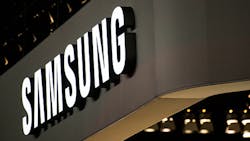Samsung Is Planning to Lower Chip Growth to Maintain Prices
Samsung Electronics Co. is planning to curtail growth in memory chip output next year to keep supplies tight amid an expected slowing in demand, according to people briefed on the matter.
The move would help maintain or drive up semiconductor prices, the people said, asking not to be identified discussing the plan. Samsung now expects bit growth of less than 20% for dynamic random access memory and a rise of 30% for NAND flash, the people said. Samsung said earlier this year it expected increases of 20% for DRAM and 40% for NAND in 2018.
Bit growth, which refers to the amount of memory produced, is a key barometer for gauging market demand. A weaker forecast may lead chipmakers to cut investment, such as orders for equipment and materials, while also limiting supply and pushing up prices. Samsung is the world’s biggest producer of NAND and DRAM, and along with SK Hynix Inc. and Micron Technology Inc., it dominates supply of the key ingredient in smartphones, computers and other devices that store digital data.
“If Samsung does cut its DRAM bit growth, it shows the company is happy with the current oligopoly market structure,” said Anthea Lai, an analyst at Bloomberg Intelligence in Hong Kong. “It prefers keeping supply tight and prices high, rather than taking market share and risking lower prices, therefore chances for DRAM prices to stay strong is higher.”
Samsung declined to comment.
Semiconductors are the biggest and most profitable business for Samsung as it produces chips for its own devices and sells to other smartphone makers. The chip division generated operating income of 35.2 trillion won (US$31.4 billion) in 2017, more than doubling from a year earlier, which helped drive the company’s earnings to a record.
Shares of Samsung have fallen 7.3% this year after reaching an all-time high in 2017.
Earlier this month, analysts at Morgan Stanley led by Shawn Kim predicted a weakening outlook for server DRAM and cautioned on a buildup in inventories.
Industry DRAM bit volume rose 20% in 2017, just half the 40% rate of 2016, according to IC Insights. While servers have fueled demand for memory, stalling smartphones sales around the world have raised concerns about market growth for semiconductors.
In addition to semiconductors, Samsung produces Galaxy smartphones and organic light-emitting diode screens used in Apple Inc.’s iPhones.
By Sam Kim
About the Author
Bloomberg
Licensed content from Bloomberg, copyright 2016.
